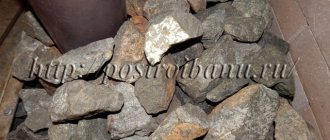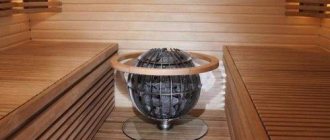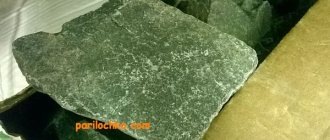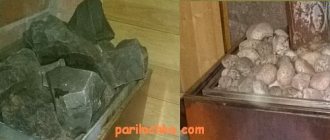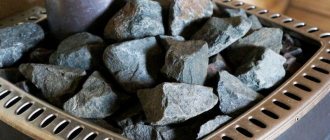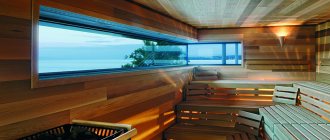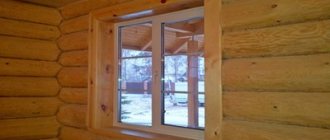Date of publication: November 06, 2019
Humanity learned to use heat and steam from heated stones for healing purposes many centuries ago. Thus, Wikipedia says that “according to the description of the ancient Greek historian Herodotus, the camp baths of the Scythian tribes resembled yurts: poles connected by the upper ends were covered with felt on top. A decoction or herb seeds thrown onto hot stones created smoke and steam.” In addition to the Scythians, many other peoples used the method of heating stones, which were placed on a fire built in a special niche, heated, and then created saturated steam from interaction with water.
Today, even after so many centuries, the principle of generating steam remains exactly the same - with only a few changes: instead of a niche with a fire, stones are now placed in a sauna stove.
How and why are bath stones used?
Like many centuries ago, stones in a modern bath or sauna are used to create steam. Saturated and healthy steam is formed when hot stones come into contact with water. To do this, the stones are heated to a high temperature using a furnace. In addition to generating steam, stones also perform another function. Thus, naturally possessing heat-accumulating properties, many types of bath stones accumulate heat and gradually release it into the surrounding space. This property makes it possible to enhance the thermal characteristics of the stove itself, and also increases the duration of bath procedures. Often, thanks to the combination of a good stove and stones, the heat in the steam room is maintained even the next day after the evening heating. And, of course, the stones in the bathhouse also perform an interior function - they are aesthetically beautiful, they add beauty to the design of the steam room - if the stove has an open design.
So, let’s summarize the three main functions of bath stones:
- Generating abundant steam
- Accumulation, preservation and release of additional heat
- Aesthetic beauty
How to lay stones in a steam room
The stones for the steam room are placed in the bath as follows:
- The largest specimens are placed in the lower tier of the heater.
- The middle stones are laid out in the middle.
- The top of the masonry is crowned with the smallest stones.
Small stones (medium size) are suitable for an iron stove. Small stones are more suitable for electric ovens. Large stones are recommended for wood burning stoves.
It is worth remembering that the correct placement of healing minerals provides high heat transfer, light steam and a therapeutic effect, which is important for bath lovers.
Criteria for choosing stones for a sauna stove
Of course, not every stone of natural or artificial origin is suitable for use in a bathhouse. Many types of stones contain impurities in their composition, which, when heated, can release harmful substances and cause damage to health. Also, not every stone is designed to interact with high temperatures, fire and water. Therefore, you need to approach the choice of stoves for a bath wisely.
There are certain requirements that apply to stone types. We list the main ones, and then consider each requirement in more detail:
- resistance to high temperatures and temperature changes
- heat capacity (heat accumulation property)
- ecological cleanliness
Characteristics of stones that are suitable for finishing steam rooms
Not all stones are suitable for a durable finish that will withstand high humidity and elevated temperatures. The basic requirements for the mineral are:
- High density.
The stone must have a dense and uniform structure. Foreign inclusions, such as mica, are unacceptable. Such products look beautiful, but can crack if water gets on them. This is unsafe because the fragments can fly in different directions and injure people. - Heat storage.
Not all stones retain heat well; preference should be given to minerals of volcanic origin. - Form.
It is better to choose round or oval stones for finishing a bath. The absence of sharp corners will increase air circulation due to uniform heating. - Dimensions.
The diameter of the products depends on the desired size of the finish. Small specimens are chosen for the stove; medium and large-sized items will look good on the walls. - Ecological cleanliness.
An important indicator is the absence of toxic fumes when heated. Therefore, some stones, for example, rubble, are not suitable for finishing steam rooms. - Strength.
The stone must be characterized by the ability to withstand numerous heating and cooling cycles, resistance to cracking and delamination. A mineral such as sandstone is not suitable due to its fragility. This stone can be used to decorate a relaxation room in a bathhouse.
Resistance of the rock to high temperatures and temperature changes - heat resistance
One of the main parameters of stones that are suitable for use in sauna conditions is thermal stability. And this is understandable - when used in a bathhouse together with a stove, the stones are subjected to severe temperature loads, because this is their task - to heat up very much.
The operating principle of a sauna stove is based on the combustion of wood, the thermal energy of which is spent both on heating the air in the steam room and on heating the stones to maximum temperatures. Then, when the temperature in the steam room reaches the required temperatures (from 70 to 100 degrees Celsius on average) and the steaming process begins, the stones are watered so that they produce steam. Upon contact with water, the stones begin to cool, and not quite evenly. Exposure to sudden temperature changes leads to the formation of cracks in the case of stones that are not designed to withstand such loads.
Heat resistance is of paramount importance - the higher it is, the stronger and more durable the stone itself. You can check the level of heat resistance of the stone yourself as follows:
- Heat the stone strongly on the fire
- Tap the stone with a hammer or something very hard, or put the stone in very cold water and check for integrity
If after the experiment the stone remains intact and does not have cracks or splits or other deformations, it means that it has a high level of thermal stability and the ability to withstand temperature changes.
The ability to retain heat for a long time - heat capacity
One of the main requirements for bath stones is the ability to heat up quickly and slowly, gradually release heat into the steam room. Such qualities allow you to warm up the steam room in a short time, while the resulting heat can be enjoyed throughout the evening, and sometimes the next morning. Stones with high heat capacity, as a rule, have sufficient mass and are distinguished by the uniformity of their structure, as well as their density. The denser and more homogeneous the stone, the higher its ability to accumulate heat. Some types of natural stones have a high level of heat capacity - nature endowed them with the necessary qualities.
Environmental safety of bath stones
It is important to understand that different types of stones may contain substances, impurities and harmful ingredients that will be released into the air when the rock is heated. Inhalation of harmful substances can lead to bad health consequences, which is fundamentally contrary to the functions of the bathhouse - to strengthen the health of the human immune system. Therefore, when choosing stones for a bath, it is very important to know their name and chemical composition. You should buy only those types of stones that are recommended for use in a bath and are specially selected for it.
What should you pay attention to when choosing stones for a bath?
When choosing stones for the stove, you should pay attention to such characteristics of the stones as:
- visual uniformity of stones
- surface type – polished or chipped. Polished stones are more suitable for creating dry steam, while crushed stones are more suitable for rich, abundant steam.
- dimensions of stones. The dimensions of the stones must correspond to the dimensions of the sauna stove. However, it is possible to combine large and small stones - this will retain steam and also increase the service life of the metal elements of the fireplace
- deposit of stones. Information about the place of extraction of stones is always indicated by the manufacturer on the packaging or in the certificate attached to the product. Packaging or documents from the manufacturer must also contain information that the stones have passed radiation control and comply with accepted standards and safety standards: environmental, chemical, operational
- no damage to stones. The selected stones should not have cracks, crumble or have other defects. The more uniform the type of stones, the longer their service life will be.
- weight of stones. The heaviest stones will have the best heat capacity. It is worth considering that heavy stones must also have a homogeneous, unified structure. In the case when the weight of the stone is not felt, it should be understood that there may be cavities and voids inside the stone, which can lead to bursting and cracking of the stone when exposed to high temperatures
What are the requirements for stones?
There are a number of requirements for the quality of minerals, ignorance of which can lead to undesirable consequences. Many natural materials contain harmful elements, which subsequently escape along with steam.
When selecting stones yourself, you should take into account the objects near which they were collected. When purchasing quality products in a store, the packaging indicates that it has passed radiation control.
The main criteria that stones for a sauna or bath must meet:
- heat resistance The stones must withstand the temperature created in the steam room and not crack in the fire. To test a cobblestone, it should be heated and placed in cold water. A good quality stone will not crack or burst as a result;
- size and shape . They are selected depending on the type of stove. For a large wood-burning stove, large cobblestones with a diameter of 80 to 120 mm are suitable. When using small electric furnaces, you need to select smaller stones - with a diameter of approximately 50 mm. The shape of minerals can be different. Laying flat small stones is easier.
- heat capacity , which determines the ability to accumulate heat and generate heat. Stones that retain heat for a long time are heavier and have a dense, homogeneous structure.
The best option for saunas with a heater are salt bricks, which can be purchased in special stores.
In addition to the basic qualities that allow you to retain heat, the aesthetic side of the issue is of no small importance. Combinations of different minerals can harmonize with the overall interior of the steam room. Natural materials can be processed - sanded or rolled.
This gives the boulders a more rounded shape. Many stones look good in their original form. Complex combinations can be created. For example, shungite goes well with jadeite, basalt with white quartz or colored quartzite.
Types and characteristics of bath stones
So, let's move on to the most important and interesting thing - the types and properties of stones that are suitable for baths and used together with modern sauna stoves. There are many types of such stones, and they all have their own characteristics and nuances. Choosing a specific type of stone is based on the technical parameters of the sauna stove, steam room and personal preferences.
Sea or river pebbles
This option is interesting because it is quite affordable, and in some cases, completely free. For example, you can collect pebbles for a bath yourself near a river or on the sea coast. The only difficulty is transporting a sufficient number of stones to the bathhouse. However, when buying pebbles, the user will spend very little money, since this type of bath stones costs very little, and is sold almost everywhere. When collecting or purchasing pebbles yourself, it is advisable to choose flattened or oval stones. Stones of this shape will fit into a dense masonry, due to which the circulation of steam between them will be more efficient.
It is worth knowing that red blotches on the surface of the pebbles indicate the presence of harmful substances in the stone that will be released when heated, so such specimens should be avoided. Most often, pebbles are used for laying the lower layers in a heater, while the upper layers are filled with better stones. For a bath, it is advisable to use river pebbles, since sea pebbles have a short service life.
Jade
The next type of stone suitable for use in a bathhouse is jadeite. At its core, it is a mineral with a green tint.
Among the main characteristics of this stone are:
- resistance to high temperatures and temperature changes
- good heat capacity
- long service life
- aesthetics
- versatility (can be used both for a heater and for decorating a steam room)
- ability to ionize air
- positive effect on the nervous and circulatory system
- increasing the overall tone of a person
- prevention of kidney and heart diseases
Soapstone chlorite
Soapstone is the real pride of Finland, as it is mined on the territory of this country and has excellent properties, moreover, natural ones. This stone is characterized by the highest level of heat capacity - it heats up quickly and actively accumulates thermal energy, which it then gradually and evenly releases into the surrounding space over a period of 2 to 24 hours.
This mineral has a thermal spectrum identical to the sun's rays, so the heat from this stone is perceived most comfortably by a person, and the steam created by the stone is felt as a gentle, velvety touch. An important indicator is that soapstone is able to withstand record high temperatures up to 1500 degrees Celsius without any consequences for its structure and integrity. This stone is environmentally friendly, does not have any impurities, therefore, when heated, the release of substances harmful to humans is excluded.
Among the beneficial properties for humans from heating soapstone are:
- strengthening the immune system
- strengthening the body's resistance to infectious diseases
- accelerating the body's metabolic processes
- prevention of diseases of the respiratory system and lungs
Soapstone has a natural shade - dark gray or light gray, characterized by the presence of unique veins that make it attractive and unique. Due to its visual properties, this stone is used not only to fill the casing of the heater, but also to decorate walls, ceilings and floors in the steam room.
Gabbro-Diabase
Gabbro-diabase is of volcanic origin and in its chemical composition the rock is close to basalt. This stone is known for its excellent heat-accumulating properties, as well as its ability to release accumulated heat for a long time. It withstands high temperatures and temperature changes well, and is not prone to cracks and splits. But there is also a minus - when heated strongly, gabbro-diabase can begin to emit a not very pleasant aroma, which at times repels fans of bath ceremonies. However, the affordable price of this stone is quite attractive, and the unpleasant smell can be “killed” by using special essential oils in the steam room. Diabase has a black-green or dark gray surface color with veins, due to which it is often used for decorative properties.
Raspberry quartzite
This stone is called “royal” due to its amazing purple color and excellent properties. It has high heat capacity, good density, and can simultaneously be used both for masonry in the stove and for decorating the surrounding space. When choosing crimson quartzite, it is advisable to give preference to already treated stones, since untreated quartzite may begin to crumble over time.
The following beneficial properties of quartzite for human health are distinguished:
- prevention of diseases associated with blood pressure
- cure pain in muscles and joints
- prevention of heart problems and diseases
- prevention of hypertension
White quartz
White quartz is also used in sauna stoves, but, to be honest, it is not very suitable for these purposes, since it does not withstand high temperature loads. But on the other hand, white quartz actively releases oxygen, enriching it with steam, which is a very useful property for the human body. When heated, the stone also releases ozone, which helps cleanse pores and rejuvenate the skin. Therefore, representatives of the fair sex often choose this stone for a bath. In order to extend its service life, you simply need to periodically inspect the masonry, replacing cracked specimens with new stones.
Quartz Peridotite
This mountain stone is of igneous origin and is characterized by a composition that is free from harmful impurities. It is considered one of the most environmentally friendly rocks. It has excellent heat-accumulating properties, due to which it heats up quickly and releases the accumulated heat into the steam room for a long time. Moreover, Peridotite quartz is able to withstand colossal temperature loads up to 1800 degrees Celsius. In addition, other positive characteristics of this stone are known:
- purifies the air
- has a very beautiful color
- can be used both for sauna stoves and for room decoration
Basalt
Basalt is an affordable and fairly strong stone, which, in addition to strength, also demonstrates excellent heat-intensive qualities. Basalt can withstand high temperatures and temperature changes, and is also characterized by rapid heating. In addition, it has the following positive aspects:
- produces abundant steam
- has a positive effect on the respiratory system
- has a pronounced antibacterial effect on the skin
- Suitable for relieving migraines
- suitable for preventing colds
Porphyrite
Porphyrite stone perfectly withstands high temperature loads, making it excellent for baths. It has an interesting feature - when heated for the first time, porphyrite makes a crackling sound, which goes away after several cycles of heating the furnace. The use of porphyrite stone is recommended for headaches, for the prevention of lung and heart diseases, as well as for skin diseases.
Cast iron core stones
Cast iron cores can be used to create the bottom layer of the furnace masonry. They have excellent heat-storing properties, increased strength and durability. When heated, they do not emit any harmful substances or odor. Cast iron cores are very cheap and therefore are often used to save money - by laying out the bottom layer of the casing with cast iron stones, the user enhances the thermal properties of the stove and at the same time saves the consumption of expensive rocks. More expensive and attractive stones are laid out on top.
Composite ceramic stones
Many manufacturers, especially Finnish ones, produce their own versions of bath stones. Most often, these are ceramic composite stones, which have increased wear resistance, durability and excellent heat-accumulating properties. Such stones are environmentally friendly, characterized by excellent compatibility with bath equipment and resistance to direct fire and high temperatures. An additional advantage is the uniformity of the stones and beautiful appearance.
Popular minerals and their characteristics
The characteristics of the stones most suitable for use in baths are listed below:
Chromite
Heat capacity kJ/kg*С0 - 0.92
A natural mineral of igneous origin, 90% consisting of chrome spinels. It contains olivine, serpentine and pyroxene, and may contain Mg and Zn elements.
It has a high specific gravity, heat capacity, strength, is non-toxic and does not interact with the liquid medium even at high temperatures.
The stone has long been used in folk medicine to treat pathologies of the reproductive system. It has powerful energy, improves immunity, and treats colds.
Soapstone chlorite
Heat capacity kJ/kg*С0 - 0.98
Eco-friendly material that has the ability to retain heat throughout the day. Allows you to obtain a large amount of steam with a minimum number of cobblestones. Before first use, it requires piercing and washing, which eliminates the formation of dust.
It has a lot of healing properties: strengthens the body, adds vitality, increases immunity, promotes the synthesis of vitamin D in the body, and normalizes metabolism. Soapstone emits soft heat, similar to that of the sun.
White quartz
Heat capacity kJ/kg*С0 - 0.75
The material is not very strong and durable, it can crack when heated, but it has excellent aesthetic qualities. The translucent white minerals look stylish in the oven and produce a lot of steam.
A distinctive feature of white quartz is the release of fragrant ozone upon sudden cooling after heating. The mineral stimulates brain activity, has a beneficial effect on the nervous system and enriches tissues with oxygen.
Dunit
Heat capacity kJ/kg*С0 - 1.00
The black rock, consisting of olivine and pyroxene, does not emit harmful impurities when heated.
It has a low coefficient of linear expansion and high specific heat capacity. Thanks to this, it does not crack and can withstand high temperature loads.
The stones do not have decorative properties, but their natural irregular shape provides a large area of evaporation. By interacting with carbon dioxide, peridotite purifies the air, helps cure colds, and stabilizes blood pressure.
Quartzite
Heat capacity kJ/kg*С0 - 0.70
Durable, wear-resistant cobblestones with high density and low water absorption. Quartzite does not lose its external qualities during prolonged use, does not crumble and does not emit harmful substances.
It comes in crimson, yellow and gray colors. Useful in the treatment of vegetative-vascular diseases and pulmonary pathologies. Helps improve blood circulation, normalizes blood pressure, and heals joints.
Basalt
Heat capacity kJ/kg*С0 - 0.84
Basalt or vulcanite is naturally durable and resistant to high temperatures. It has very low water absorption properties and has a high heat capacity.
The mineral is capable of intensively generating healing steam. Increases blood pressure, helps with colds, joint inflammation, migraines, nervous system disorders and eczema.
Combination of different types of stones for a bath
It is worth considering that filling the stove casing with only one type of stone is not at all necessary. On the contrary, the combination of different rocks is often recommended to obtain richer, more abundant and beneficial steam. For example, the lower layers of a stone casing can be filled with inexpensive pebbles, cast iron cores or basalt, and the upper layers can be used for masonry with soapstone and peridotite.
How to properly arrange the rocks in the heater?
- Selecting and buying suitable stones for a bath is half the battle. It is equally important to position them correctly in the stone casing or in the stove itself. The circulation of heated oxygen, in particular, and the quality of bath procedures in general, will depend on the location of the stones. Before laying the stones, it is recommended to thoroughly wash and dry the stones in order to get rid of possible dirt and dust that will enter the steam room air when heated.
- The main principle of laying is that large specimens of rocks are first placed at the bottom of the casing or compartment for stones, and only then small ones. Oblong-shaped stones should be laid vertically so that they warm up faster.
- It is also important to make the correct calculation of the required number of stones. The calculation should be made based on the dimensions of both the stove itself and the steam room. The surest way is to use the manual for the heating device, in which the manufacturer provides the recommended number of stones.
Advice: heating equipment manufacturers and bathhouse attendants recommend inspecting the stones once or more times a year. Stones should be inspected for chips, cracks, plaque and other defects. Damaged stones should be replaced with new ones.
Basic rules for using stones and some advice from bathhouse attendants
Experienced bathhouse attendants recommend some actions that will help you get the maximum benefit and pleasure from bathing procedures using stones. Thus, it is recommended to disinfect bath stones from time to time, because during use the stones are exposed to water, steam and temperature - some rocks may be subject to the formation of harmful plaque, mold or fungi. To disinfect stones, they are soaked in a large container (for example, in a basin or bucket) for about a day, using an ordinary salt solution (proportion 1 to 3). After soaking for a day, the stones should be thoroughly rinsed and dried.
In addition to disinfecting stones, bath attendants also recommend using other tricks.

